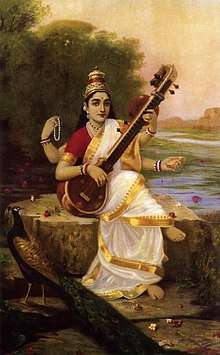Teental
Teental (alternatively spelled tintal, teentaal, or tintaal, and also called trital; Hindi: तीन ताल) is the most common tala of Hindustani music, and is used for drut (fast-tempo) Khyal. The structure of tintal is so symmetrical that it presents a very simple rhythmic structure against which a performance can be laid.[1]. It is played on Tabla as well as on Percussion instruments.
Arrangement
Tintal has sixteen (16) beats[2] in four equal divisions (Vibhag). The period between every two beats is equal. The first beat out of 16 beats is called sam and the 9th beat is called khali ('empty'). To count the Teental, the audience claps on the first beat, claps on the 5th beat, then waves on the 9th beat and lastly again claps on the 13th beat; these three claps (Hindi tin 'three' + tāl 'clap') give the rhythm its name.
Uses
Tintal can be used for both accompaniment and solo. There are various Kaidas and Parans for it. Tintal is the widely used tal. The Tintal is mostly used in the drut laya and Zhalas. When Tintal is played at a fast rate or in the drut laya then it sounds as if tintal is played in the reverse i.e. the reverse of tintal would be
DHA DHIN DHIN DHA |
DHA DHIN DHIN DHA |
NA TIN TIN TA |
TA DHIN DHIN DHA |
Theka
मात्रा भाग : ४-४-४-४.
धा धिं धिं धा - धा धिं धिं धा - धा तिं तीं ता - ता धिं धीं धा
It has a characteristic pattern of bols (theka).
| dha | dhin | dhin | dha | | | dha | dhin | dhin | dha | | |
| x | 2 | ||||||||
| dha | tin | tin | Na | | | Tetey | dhin | dhin | dha | | |
| o | 3 |
This can also be shown using the following figure[2]
| Taal signs | X | 2 | 0 | 3 | ||||||||||||
| Maatra | 1 | 2 | 3 | 4 | 5 | 6 | 7 | 8 | 9 | 10 | 11 | 12 | 13 | 14 | 15 | 16 |
| Bols | dha | dhin | dhin | dha | dha | dhin | dhin | dha | dha | tin | tin | ta | ta | dhin | dhin | dha |
Note the bols used for the first beat of each division: Dha, a bol involving both hands, is played at the beginning of the first, second and final divisions; for the khali section, Naa – a right hand bol – is used to indicate that the division is open. There are some pedagogical variations as to the actual syllables pronounced when reciting the bol, most of which occur in the final two vibhags.
Also note that this variation is from the Lucknow Gherana.
References
- Indian Music - Tintal (Teental)
- Sarah M. Van Doel (2008). Sikh Music: History, Text, and Praxis. ProQuest. pp. 57–. ISBN 978-0-549-83369-7. Retrieved 1 July 2012.
